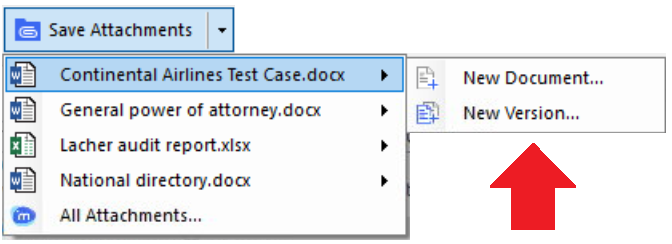Tips for iManage Work end-users
You can ramp up quickly with these helpful Work 10 tips and tricks:
In iManage Work Desktop for Windows
Linking Outlook folders to iManage folders
Whether you have dozens of existing Outlook folders, or you are creating new ones, you can easily link them to iManage. This enables you to file emails to iManage simply by dragging them to a "Filing Folder" (a.k.a. "Linked Folder").
To link an existing Outlook folder:
- Right-click the folder and select Properties.
- Select the File to iManage tab.
- Search for the desired matter and select its "Email" folder.
- Select OK.
Anything that is already in the folder when you link it will eventually get a Green checkmark, indicating that it is now filed to iManage. Drag new emails in there; they too will be filed.
To link an Outlook folder when you create it:
- Create an Outlook folder. You will be prompted to link it to iManage.
- Select Yes.
- Search for the desired matter and select its "Email" folder.
- Select OK.
Bonus:
• Do you create Outlook rules to move emails to folders? If those rules send emails to a linked folder, those items will be filed to iManage.
• If you create linked folders on your laptop/PC, you can file emails to them from your smartphone by using to the "move" option. (From an iPhone, swipe left and choose "Move.")
Saving document version as PDF
When an iManage document is in its final form, you can quickly PDF it on the fly. This will work with Microsoft Word, Excel, and PowerPoint.
To save a document version as PDF:
- Select the iManage tab on the ribbon bar.
- Choose Save as PDF.
- Select whether you want to save it as a New Document or New Version:
- If choosing New Version, make any notes in the Comments fields you wish.
- If choosing New Document, you will need to search for the folder where you want the PDF copy to be filed, for example, the "Final" folder.

Saving attachments/versions in iManage Work 10
Any attachments to emails in your Microsoft Outlook mailbox are eligible to be filed to iManage. You have two options to save the attachment:
- As a New Document
- As a New Version
Both methods are available by selecting the Save Attachments button in the filing toolbar in Outlook:


To save as a New Document:
- Highlight the email with attachment(s).
- Select the Save Attachments button in the filing toolbar.
- Select New Document.
- When the Save As dialog box appears, locate the desired workspace (matter) and then select a folder.

- Select Save.
NOTE: If there are multiple attachments to an email and you want to file them all to the same workspace (matter), select the All Attachments option and then the New Document option. This will save all attachments to the desired folder in a single action.
To save as a New Version:
- Highlight the email with attachment(s).
- Select the Save Attachments button in the filing toolbar.
- Select New Version.

- In the Open dialog box, locate the desired document (that is, the one for which you would like to create a New Version), and choose Select.
- In the New Version dialog box, make any desired changes to the new version, for example, add Comments, change Author (Optional).

- Select Save.
NOTE: With the New Version option, you will not be asked where the attachment should be filed in iManage. This is because all versions must reside in the same folder, so the system already has that information.
Comparing two versions of the same Microsoft Word document
A general rule of thumb for iManage integration with the Microsoft Office suite is, "if it can be done in Office, it can be done in iManage." One example is the ability to use the native Compare/Combine feature in Microsoft Word to Compare or Combine two Word documents saved to iManage. Where it gets a little tricky is when you are comparing two versions of the same document if both versions are not on your recent list.
NOTE: iManage is configured to only show the latest version in most views, but other versions will display in Recent Documents.
With Work 10 integration for Microsoft Office, there's an easy way around that conundrum: the Versions ribbon item. Follow the steps below and you'll be redlining with ease:
Compare two versions of an iManage document:
- Open one iManage Word document you are interested in comparing.
- From the iManage ribbon, select the Versions ribbon item.
- In the iManage pane, click the kebab menu for the version you want to compare.
- Select the Compare option from the kebab menu. The Compare tool will open and both versions will be selected and ready to be compared.
NOTE: These steps require a user to have iManage Work Desktop for Windows installed.
In iManage Work web application
Using the Timeline to audit a document
The Document Timeline in Work 10 Web is a quick way to view everything that has been done to a document since it was first filed to iManage. The timeline shows things such as who took an action ("Preston Hobson"), what they did ("Modified Version 1"), which tool they used ("Work Web"), and when they took the action ("Jun 26, 2019 4:57 p.m.").
If you have rights to a document, you have rights to its audit trail. You can find the Document Timeline in Work 10 Web from the right-click or kebab menu, or from a document preview.